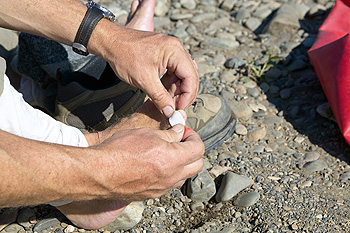How Blisters Serve a Purpose
Tuesday, 01 February 2022 00:00When skin becomes damaged due to friction, a small bubble of fluid can form in the epidermis in order to protect the layers of skin beneath it which allow the skin to heal. Blisters are typically filled with a clear serum, but in some cases where there is excess pressure or friction, the sac may fill with blood. If the blister becomes infected, pus may collect in the blister. An infected blister may also become red, swollen, or painful. Most blisters will heal on their own if they are left alone, allowing the new skin to grow underneath it. Blisters should not be popped, as they provide a protective barrier that keeps bacteria away from the damaged skin to ward off further damage and infection. Wearing shoes that fit properly and are flexible can go a long way in avoiding blisters from forming. Socks that are clean and keep moisture away from the skin are also beneficial, as moist skin can blister more easily. If a blister becomes infected, it is suggested that you contact a podiatrist who can help cure the infection, help your skin to heal, and offer preventive methods to avoid the formation of blisters.
Blisters are prone to making everyday activities extremely uncomfortable. If your feet are hurting, contact Dr. Mark Spier of Maryland. Our doctor can provide the care you need to keep you pain-free and on your feet.
Foot Blisters
Foot blisters develop as a result of constantly wearing tight or ill-fitting footwear. This happens due to the constant rubbing from the shoe, which can often lead to pain.
What Are Foot Blisters?
A foot blister is a small fluid-filled pocket that forms on the upper-most layer of the skin. Blisters are filled with clear fluid and can lead to blood drainage or pus if the area becomes infected.
How Do Blisters Form?
Blisters on the feet are often the result of constant friction of skin and material, usually by shoe rubbing. Walking in sandals, boots, or shoes that don’t fit properly for long periods of time can result in a blister. Having consistent foot moisture and humidity can easily lead to blister formation.
Prevention & Treatment
It is important to properly care for the affected area in order to prevent infection and ease the pain. Do not lance the blister and use a Band-Aid to provide pain relief. Also, be sure to keep your feet dry and wear proper fitting shoes. If you see blood or pus in a blister, seek assistance from a podiatrist.
If you have any questions, please feel free to contact one of our offices located in Columbia and Reisterstown, MD . We offer the newest diagnostic and treatment technologies for all your foot care needs.










